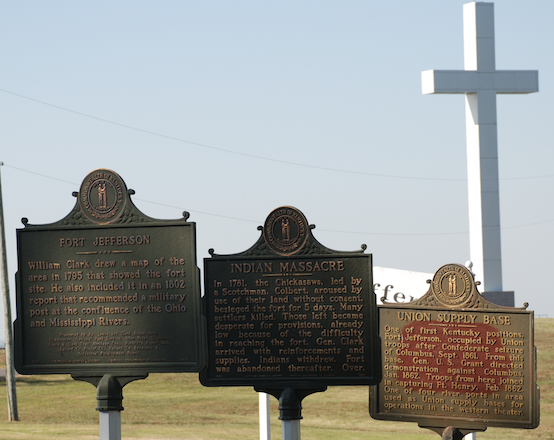By Berry Craig
NKyTribune columnist
History barely records the story of Nancy Ann Hunter, the teenage heroine of old Fort Jefferson.
The 15-year-old braved a withering fire from besieging Indians to fetch a milk cow and calf, thereby “saving young lives.” Or she swam the Mississippi River to bag a buffalo, thus providing sustenance for the fort’s hungry defenders.
Modern historians suggest both tales from the American Revolution are more fiction than fact.
Even so, early 20th-century Kentucky historians Temple Bodley and Samuel M. Wilson claimed the story was true. Had the youth lived in New England, with is plentiful printing presses and book publishers, “Nancy Ann Hunter would be celebrated in history, romance and song, and known to every school girl in the land,” they wrote.

Not much is known of Nancy Ann. Not a trace remains of Fort Jefferson or of Clarksville, the youth’s hometown which sprang up around the log-walled, 100-foot-square bastion on a bluff top above the Father of Waters.
The fort site is about a mile south of Wickliffe, the Ballard County seat, on U.S. 51. Historical markers, one inaccurate, tell about Fort Jefferson, but not about Nancy Ann.
Anyway, the spot is better known for the Fort Jefferson Cross, a 90-foot metal crucifix visible for miles.
The fort opened in June, 1780. It was supposed to guard the nearby confluence of the Mississippi and Ohio rivers.
Gen. George Rogers Clark named the fort for Gov. Thomas Jefferson of Virginia. Clarksville was named for the general but nothing was named for Nancy Ann.
Clark was a Virginian and until statehood in 1792, Kentucky was the westernmost part of the Old Dominion. Nonetheless, the fort was on Chickasaw land and the Native Americans viewed the whites as invaders.
The Chickasaws were especially angry because Clark built the fort without their permission. He didn’t even consult them.
Ultimately, the Native Americans, who were British allies, decided to drive the whites out. Led by a British officer, they laid siege to the fort on Aug. 27.
The Chickasaws, according to a contemporary account, “Gathered all their force and at Night began a tremenduous [sic] fire on the fort Advancing up from all quarters till they were Crouded [sic] very Close.”
Civilians from Clarksville, including Nancy Ann, took shelter inside Fort Jefferson. Among the families “were many infants, likely to die for want of nourishment,” Bodley and Wilson wrote in their 1928 History of Kentucky.
After the battle began, somebody in the fort supposedly spied a bovine and her issue in the no-man’s land between attackers and defenders. While the menfolk covered her with musket and cannon fire, Hunter took off on her death-defying dash.
She survived unscathed even as Indian bullets “whistled by and cut her clothing.” Yet “bringing that cow into the fort meant the saving of young lives,” according to the book.
Lacking artillery that could knock down the fort’s walls, the Chickasaws gave up and left on Aug. 30. The fort was abandoned in June, 1781.
Anyway, an even taller tale is told about the teen. In that yarn, Hunter went buffalo hunting to save the fort, which was running out of food.
She spotted a bison on the shore across the wide waterway. Fully clad in a long dress, she slung a musket across her back, jumped in the river and started swimming toward the beast, which accommodatingly stayed put.
No sooner was Nancy Ann on terra firma than she bagged the buffalo with a single shot, dragged the carcass to the river and crossed back, clinging to the lifeless bison as an edible life raft.
Or so the story goes.
Berry Craig of Mayfield is a professor emeritus of history from West Kentucky Community and Technical College in Paducah and the author of five books on Kentucky history, including True Tales of Old-Time Kentucky Politics: Bombast, Bourbon and Burgoo and Kentucky Confederates: Secession, Civil War, and the Jackson Purchase. Reach him at bcraig8960@gmail.com

















